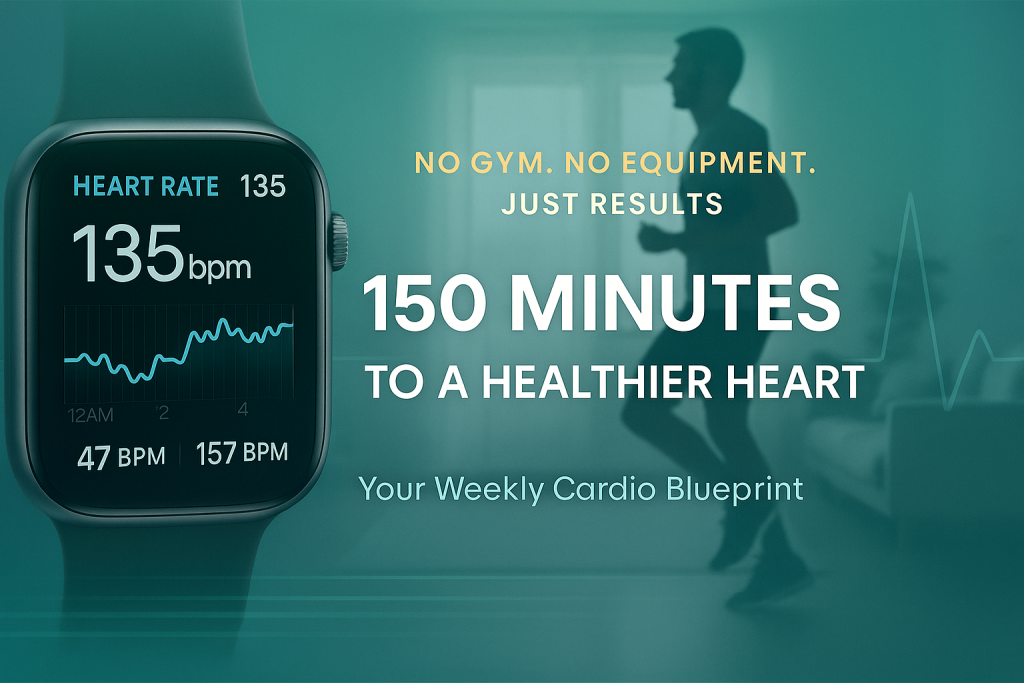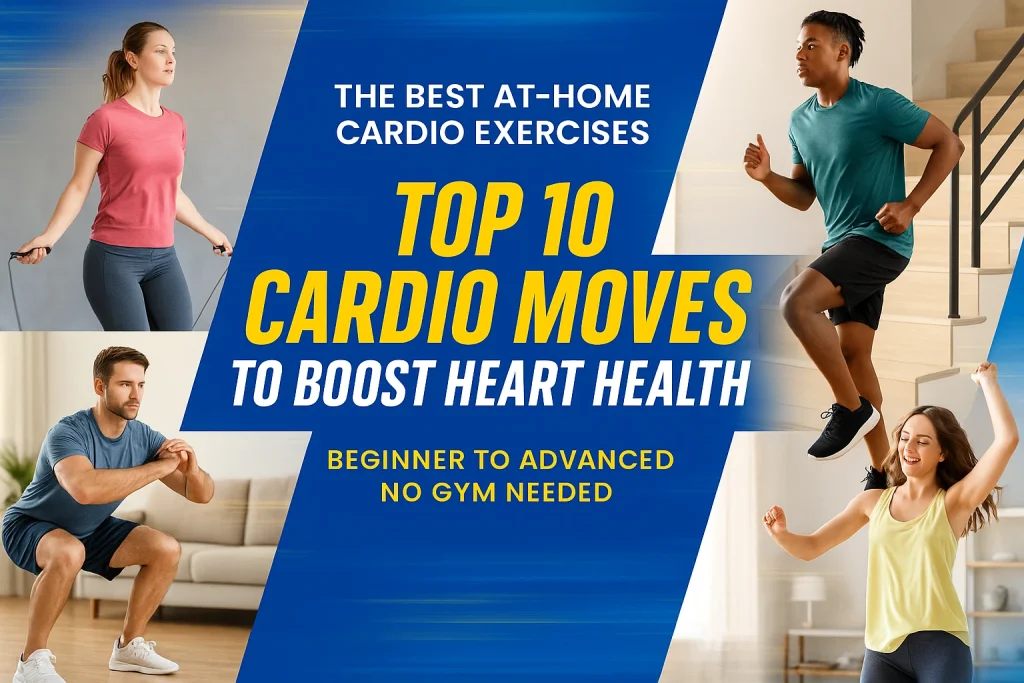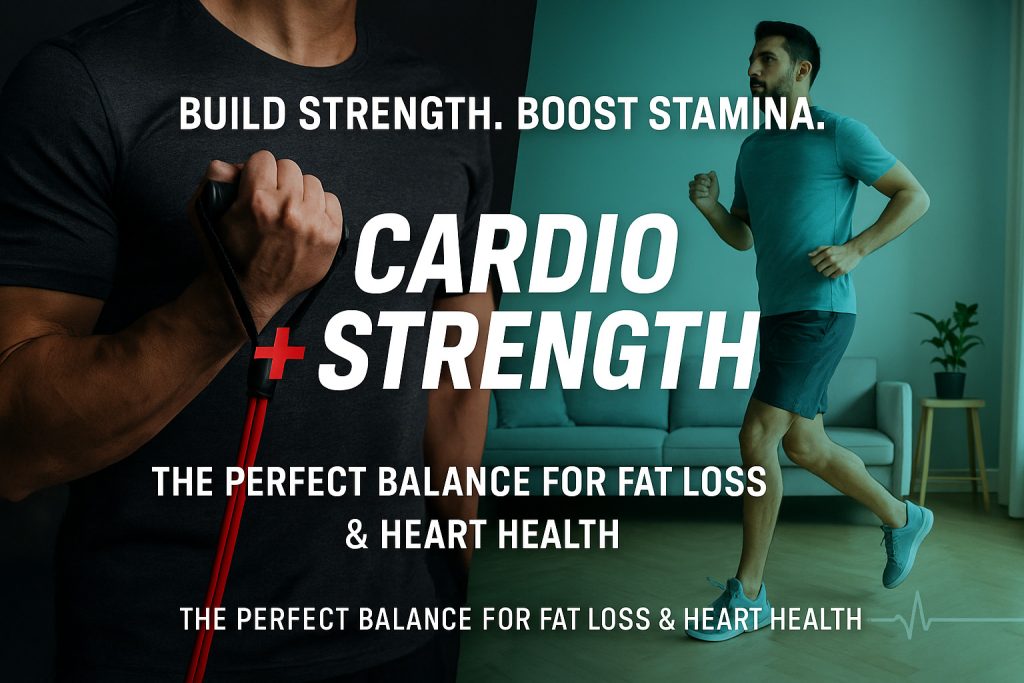Staying active doesn’t always require a gym membership or fancy equipment. Simple cardio workouts done at home can help you strengthen your heart, boost energy, and improve overall fitness. Whether you’re a beginner or already active, home-based cardio exercises can help you reach your health goals safely and efficiently.
This complete guide explains why cardio workouts are important, how much cardio you need, and which exercises you can do to stay fit, lose weight, and keep your heart healthy.
Which Are the Exercise To Remove Heart Blockage
Cardio workouts, also called aerobic exercises, are activities that increase your heart rate and breathing for a sustained period. These include movements such as jogging, dancing, brisk walking, or cycling.
A strong heart pumps blood more efficiently, improves oxygen flow, and keeps your body functioning well. Regular cardio helps to:
- Strengthen your heart, lungs, and blood vessels
- Lower cholesterol and blood pressure
- Improve metabolism and endurance
- Boost energy, mood, and sleep quality
- Support long-term heart health and weight management
Without regular physical activity, the heart becomes weaker, circulation slows, and the risk of diseases like diabetes or hypertension increases. Adding proper cardio workout to your daily routine can prevent these issues and improve longevity.

How Much Cardio Should You Do Each Week
To gain the benefits of cardio workouts, consistency is key. According to the American Heart Association and global fitness guidelines:
- Do 150 to 300 minutes of moderate-intensity cardio per week, or
- Do 75 to 150 minutes of high-intensity cardio workouts per week
Moderate-intensity activities include brisk walking, steady cycling, or light jogging.
Vigorous-intensity exercises include running, HIIT, or jump rope.
If you’re just starting out, begin with 15 to 20 minutes a day and gradually increase your time and intensity. Over time, aim for:
- 3–5 cardio sessions per week
- 1–2 rest or recovery days
Remember that recovery allows your heart and muscles to rebuild stronger after each workout.

At Best Home Cardio Workouts for Beginners to Lose Weight
If you’re new to exercise, start with low-impact movements that get your body moving without straining your joints. These beginner-friendly cardio workouts can be done anytime, anywhere.
Marching in Place
Marching is one of the easiest ways to raise your heart rate and prepare your body for movement.
- Stand straight with your feet shoulder-width apart.
- Lift your knees one at a time as if you’re marching.
- Swing your arms naturally to engage your upper body.
- Gradually pick up the pace.
Duration: 1–2 minutes for 3 rounds.
Dancing to Music
Turn your favorite music into a full-body workout. Dancing improves coordination and endurance while burning calories.
- Choose upbeat songs.
- Move your arms and legs freely in rhythm.
- Keep moving without long pauses to maintain your heart rate.
Duration: 10–15 minutes of continuous dancing.
Arm Circles
Arm circles improve blood flow and shoulder mobility while adding light cardio movement.
- Extend your arms out to your sides.
- Make small forward circles for 30 seconds.
- Switch to backward circles for another 30 seconds.
- Keep your core tight and posture upright.
Duration: 1–2 minutes.
Air Squats
Squats strengthen your legs and glutes while providing mild cardiovascular benefits.
- Stand with feet shoulder-width apart.
- Lower into a squat position by bending your knees.
- Keep your back straight and chest up.
- Return to standing and repeat.
Reps: 10–15 per set for 3 sets.
These simple at-home cardio workouts help beginners build a strong foundation and improve endurance gradually.
At Best Home Cardio Workouts for Intermediate to Lose Weight
Once your fitness improves, try slightly harder cardio workouts that challenge your heart and body more effectively.
Jogging in Place
Jogging in place increases endurance without needing much space.
- Jog lightly while lifting your knees.
- Land softly and move your arms as you jog.
- Maintain a steady pace.
Duration: 2–3 minutes per round.
Jumping Jacks
This full-body cardio move is simple and effective.
- Start with your feet together and arms down.
- Jump up while spreading your legs and raising your arms overhead.
- Jump again to return to the start position.
Duration: 30–60 seconds for 3 rounds.
Stair Climbing
If you have stairs at home, this is a great workout for your legs and heart.
- Walk or jog up and down the stairs repeatedly.
- Maintain control and use the railing if needed.
- Increase speed or add a backpack for extra resistance.
Duration: 3–5 minutes per set.
Squat with Front Kick
Combining squats and kicks builds coordination and balance.
- Perform a normal squat.
- As you stand, kick one leg forward.
- Alternate legs after each squat.
Reps: 10 per side for 2–3 sets.
These intermediate cardio workouts build both strength and stamina while burning more calories.
Advanced Cardio Workouts for Greater Endurance
For those with a solid fitness base, these advanced exercises will raise your heart rate and burn fat faster. Perform them carefully with proper warm-up and form.
Jump Rope or Air Jump Rope
Jump rope training is one of the most efficient cardio workouts for fat burning.
- Use a real rope or mimic the movement without one.
- Jump lightly on the balls of your feet.
- Keep your arms close to your body and rotate from your wrists.
Duration: 1 minute on, 30 seconds rest. Repeat 4 rounds.
Mountain Climbers
A challenging move that targets the core and legs while improving cardio fitness.
- Start in a push-up position.
- Quickly switch legs, driving your knees toward your chest.
- Keep your hips low and body straight.
Duration: 45 seconds per round.
Burpees
A powerful, full-body exercise for calorie burning and endurance.
- Stand tall, then drop into a squat position.
- Place your hands on the floor and jump your feet back into a plank.
- Jump your feet forward again and leap into the air.
Reps: 8–12 per round for 3 rounds.
Squat Jumps
Squat jumps add explosive movement to your lower body workout.
- Perform a squat, then jump up as high as possible.
- Land softly and go straight into the next rep.
Reps: 10–15 per round for 3 sets.
These advanced cardio workouts significantly improve endurance, heart strength, and calorie burn.

Low Impact Cardio Workouts For Bad knees
If high-impact exercises like jumping cause discomfort, try these joint-friendly alternatives.
- Step Touch: Step side to side and swing your arms gently.
- Seated Knee Lifts: Sit in a sturdy chair and lift one knee at a time.
- Slow Dancing: Move lightly to music without sudden jumps.
- Elliptical or Stationary Bike: Ideal for smooth, low-stress cardio movement.
These low-impact cardio workouts are great for beginners, seniors, or anyone recovering from an injury.
How to Combine Strength and Cardio at Home
Mixing strength training with cardio workouts creates a balanced routine that improves heart health and builds muscle.
Here’s a sample weekly plan:
- Monday: 30 minutes of home cardio (HIIT or steady state)
- Tuesday: Strength training (bodyweight exercises)
- Wednesday: Rest or light yoga
- Thursday: 25 minutes HIIT cardio
- Friday: Strength workout or resistance bands
- Saturday: Outdoor walk, cycling, or fun activity
- Sunday: Rest and recovery
If your goal is fat loss, perform cardio after strength training.
If you want better endurance, do cardio before lifting.
Warm up before and cool down after every workout to stay injury-free.

How to Make Cardio Exercising Fun and Sustainable
Many people stop working out because it feels repetitive. Here’s how to make your cardio workouts enjoyable and consistent:
- Pick activities you enjoy—dancing, hiking, or even jump rope.
- Play motivating music during your workouts.
- Try online cardio classes for variety.
- Track your progress with a notebook or fitness app.
- Set weekly challenges, such as “20 minutes every morning.”
- Exercise with a friend or family member for accountability.
The best workout is the one you’ll stick with. Consistency is the foundation of long-term fitness.
Safety Tips Before and After a Cardio Workout
Safety should always come first during home workouts. Follow these guidelines:
- Clear enough space to move freely.
- Wear non-slip shoes and comfortable clothes.
- Warm up for 5–10 minutes with gentle movement.
- Stay hydrated throughout your session.
- Cool down with stretching to prevent stiffness.
- Stop if you feel pain, dizziness, or shortness of breath.
- Always consult a doctor if you have existing heart or joint conditions.
Following these tips ensures your cardio workouts are both safe and effective.
Watch for more info:
FAQs
1. How much cardio should I do for weight loss?
To lose weight, aim for 150–300 minutes of moderate or 75–150 minutes of vigorous cardio per week. Combine cardio with a calorie-controlled diet.
2. Will cardio burn muscle?
No, moderate cardio combined with proper nutrition preserves muscle while burning fat. Overtraining without enough calories can, however, lead to muscle loss.
3. What cardio workout burns the most calories?
High-intensity interval training (HIIT), burpees, and jump rope are among the top calorie-burning exercises.
4. What is the best cardio exercise?
The best cardio workout is one you enjoy and can maintain—dancing, brisk walking, cycling, or jogging.
5. How long should a cardio workout be?
Start with 20–30 minutes per session, and increase duration or intensity as your fitness improves.
6. Why cardio is bad?
Cardio only becomes harmful when overdone without rest. Balanced cardio supports heart and metabolic health.
7. Which cardio exercise is best for heart health?
Exercises that raise your heart rate steadily—like brisk walking, jump rope, or swimming—are best for your heart.
8. How many cardio workouts should I do per week?
Four to five cardio sessions weekly are ideal, with at least one rest day.
9. Can you do cardio and strength training on the same day?
Yes. For fat loss, do cardio after lifting; for endurance, do it before. Always warm up and cool down properly.
Final Note:
Cardio workouts don’t have to be complex. Simple movements done regularly can protect your heart, improve endurance, and boost mood. Stay consistent, move daily, and make fitness a natural part of your lifestyle—your heart will thank you.







